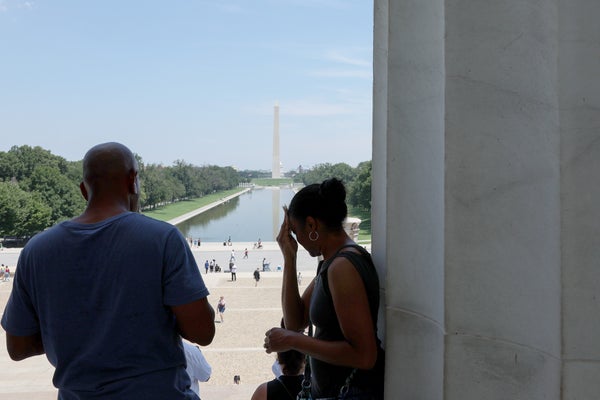CLIMATEWIRE | Daily temperature records were broken yesterday as a punishing heat wave swept across the mid-Atlantic and Northeast. Temperatures soared into the high 90s throughout much of the region, rising into the triple digits in some places.
Newark, N.J., hit 100 degrees for the fifth day in a row, breaking a daily temperature record for July 24 and hitting its longest 100-plus streak since the city began keeping records in the 1930s.
Temperatures in New York City rose into the high 90s. And the heat index — what temperatures actually feel like to the human body — exceeded 100 degrees in some areas.
On supporting science journalism
If you're enjoying this article, consider supporting our award-winning journalism by subscribing. By purchasing a subscription you are helping to ensure the future of impactful stories about the discoveries and ideas shaping our world today.
Boston hit 100 degrees yesterday afternoon, breaking a daily heat record. The previous record for that date in July was 98 degrees, set in the year 1933, according to the National Weather Service.
Providence also broke a daily heat record at 96 degrees.
And in some areas around Washington and Baltimore, the heat index rose as high as 107 degrees.
Much of the Northeast also sweltered under unusually high minimum temperatures. Nighttime lows in places like New York, Boston and Washington hovered in the high 70s over the weekend.
High nighttime temperatures are often dangerous to people’s health during heat waves. The human body relies on cooler evening temperatures to recover from the daytime heat.
Heat-related advisories went into effect up and down the East Coast from Virginia to Maine over the weekend.
Heat advisories also extended throughout parts of Texas, the mid-South, the southern Great Plains and the Midwest, which continued roasting under high temperatures over the weekend. Severe heat has gripped large swaths of the central part of the country for much of the past month.
Altogether, tens of millions of people suffered under heat advisories over the weekend.
In the Northeast, cities including Boston, Philadelphia and Washington declared heat emergencies and opened cooling centers and activated emergency response teams for residents in need. Cooling centers also opened in New York City, and public pools extended their hours.
As of Saturday night, at least one person had died of heat-related illness in New York City, The New York Timesreported. Excessive heat also reportedly contributed to at least one person’s death in Allentown, Pa., last Thursday as temperatures rose into the 90s.
Heat is the biggest weather-related killer in the U.S., causing more fatalities each year than hurricanes, floods or wildfires. It’s especially dangerous for certain vulnerable populations, including elderly people, unhoused people, those without air conditioning and people with underlying medical conditions.
And it’s growing more dangerous as the climate continues to warm.
Heat waves are growing more frequent and more intense across much of the world as global temperatures climb. That includes the Northeast, where extreme heat is expected to intensify and heat waves will happen more frequently and last longer in the future, according to the most recent National Climate Assessment.
The assessment also warns that large Northeastern cities suffer even higher temperatures than their surrounding areas because of the urban heat island effect. Cities tend to have less vegetation, more concrete and asphalt, denser buildings, and higher populations than rural areas.
That means urban populations are often at a greater risk of heat-related illness or death.
And inequalities within cities themselves mean that temperatures often differ significantly from one neighborhood to the next. Denser neighborhoods with fewer green spaces, for instance, are likely to be hotter.
Studies have found that people of color and people with low incomes are more likely to live in hotter neighborhoods across the U.S., putting them at increased risk of heat-related health hazards (Climatewire, Dec. 10, 2020).
High heat is expected to continue across much of the Northeast through today. Temperatures may finally begin to drop tomorrow.
